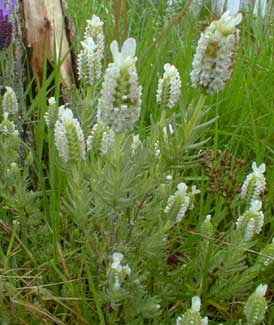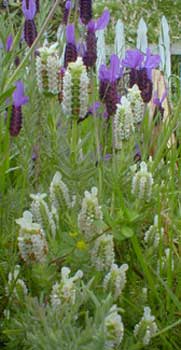 'Alba' or
'Alba' or
White Italian Lavender
"O servant-girl, singing of pear-trees in the sun,
And scraping the yellow fruit you once picked
When your lavender-white eyes were alive."
-Maxwell Bodenheim
(1893-1954)
And scraping the yellow fruit you once picked
When your lavender-white eyes were alive."
-Maxwell Bodenheim
(1893-1954)
 Frequently called a Spanish Lavender, this particular subspecies is actually from Italy. Lavandula stoechas cultivars & subspecies seem randomly to be called Spanish, French, or Italian lavenders, but strictly speaking, only the L. stoechas ssp stoechas should be designated Italian, while cultivars of the subspeces pedunculata are the Spanish or French Lavenders.
Frequently called a Spanish Lavender, this particular subspecies is actually from Italy. Lavandula stoechas cultivars & subspecies seem randomly to be called Spanish, French, or Italian lavenders, but strictly speaking, only the L. stoechas ssp stoechas should be designated Italian, while cultivars of the subspeces pedunculata are the Spanish or French Lavenders.Italian Lavender is also called Topped or Top Lavender in Australia, where it has been categorized a noxious weed since the 1920s. Modern cultivated varieties are far less likely to be invasive, & they're completely restrained in the temperate Northwest.
The variant leucantha or 'Alba' is a white-flowering form. It is not as showy as the Papillon or Butterfly Spanish Lavender cultivars (L. stoechas ssp pedunculata) such as are known for extravagant purple blooms with "rabbit ears" on top of tall stems. The Italian supbspecies has its flowers on short stems that barely poke above the foliage, & the ears are much reduced in size.
Showiness is a relative value however, & in its own right, it is an extravagant little sub-shrub in full bloom from late April all the way through Summer. It can even be a bit startling to anyone who recognizes it as very likely a lavender, but then thinks it can't be, because it isn't purple.
The white flowers of this variant are actually white with vertical green stripes, plus tiny white ears on top.
A fragrant evergreen, it is frost-hardy for winter, but will be injured if temperatures fall into the teens or stays long in the twenties. It likes a poor, light, well-draining soil in a very sunny position. It's very drought tolerant when established, but cannot abide wetness. It grows to two feet at tip of flowers, or less; its grey-green foliage clumps two feet wide or wider.
Our young start was planted in early spring 2004 & bloomed right away in April. One year later it was a substantial large clump, shown on this page in two May photos. It is doing superbly in a roadside sunny herb garden alongside a deep purple 'Otto Quast' Spanish Lavender, which makes for a striking contrast of lavenders, as can be seen in the second photo.